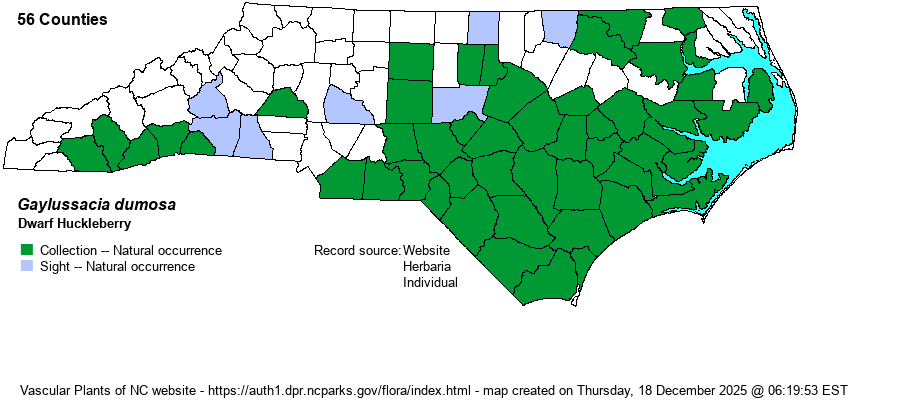| Author | (Andrews) Torrey & A. Gray | |
| Distribution | Nearly throughout the Coastal Plain, but of spotty occurrence in the northern third of the province. Scattered in the eastern third of the Piedmont and in the southern Mountains. Very widely scattered elsewhere – central and western Piedmont and most of the Mountains.
As expected, this is a Southern species of huckleberry, ranging from the Gulf States north only to central TN and then coastally north to NJ.
| |
| Abundance | Abundant in the Sandhills and other areas in the southern half of the Coastal Plain, being one of the most numerous small shrubs in this region. Uncommon (at best) in the northern Coastal Plain and eastern Piedmont. Rare to locally uncommon in the southern Mountains, and very rare elsewhere in the Piedmont and Mountains, certainly absent over most of the Mountains. | |
| Habitat | This species occurs mainly in xeric to dry sandy soils of Longleaf Pine (Pinus palustris) forests and other sandy forests and openings; a dominant shrub of the Xeric Sandhill Shrub natural community. Away from the Coastal Plain, it is found mostly in dry and sandy forest openings and edges (in acidic conditions). |
| Phenology | Blooms from March to June; fruits from June to October. | |
| Identification | This is a low-growing deciduous (to semi-evergreen) shrub, usually under 1 foot tall; it is the dominant woody plant of the shrub layer of xeric pine stands and sandhills. It has small and rather rounded, shiny and thick entire leaves, mostly only 1-1.5 inches long, and usually shows a small mucronate tip. It has a larger and wider white, bell-shaped flower than found in similar ericads of these habitats, especially Vaccinium tenellum, the only other “dwarf” ericad of dry, xeric sandy habitats. That species has narrower and more oblanceolate leaves that are not overly shiny above, and its flowers are narrower, with a more closed “mouth”. Check the species accounts of the two recent splits from G. dumosa -- G. bigeloviana and G. orocola – for identification characters of these. | |
| Taxonomic Comments | The main confusion or concern is the taxa that were formerly included within G. dumosa – namely G. bigeloviana and G. orocola. The first of these has been recently described; it occurs in coastal bogs, pocosins, and other wetlands. The second is a wetland (bog) species known from just the NC mountains. Thus, one sometimes sees the widespread sandhill taxon listed as G. dumosa var. dumosa, where one or both of the others are listed as varieties.
| |
| Other Common Name(s) | Southern Dwarf Huckleberry (used where G. bigeloviana is called Northern Dwarf Huckleberry). Bush Huckleberry and Gopherberry are occasionally used. | |
| State Rank | S5 | |
| Global Rank | G5 | |
| State Status | | |
| US Status | | |
| USACE-agcp | FAC link |
| USACE-emp | FAC link |

